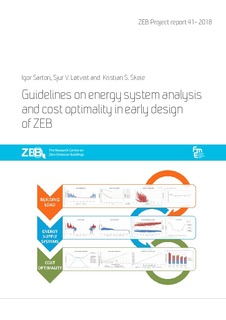| dc.description.abstract | This report presents a set of guidelines to assist building designers in a methodological approach to analysis of energy systems in the early design phase of zero emission buildings. The guidelines are meant to accompany the use of a ZEB supporting tool, guiding through the necessary steps to evaluate performance and adapt dimensioning of different systems to the case at hand (Figure 1).
The ZEB supporting tool is a post-processing tool based on outputs of hourly aggregated data produced by other building performance simulations (BPS) tools, such as thermal load, plant temperatures, mass flows and energy exchange between components. The interface is a text file written as output by a BPS tool and read as input by the ZEB supporting tool.
In theory, any building performance simulation (BPS) tool may serve the purpose, as far as it is capable of producing hourly results for the required parameters and variables. In practice, the ZEB tool has been developed "in tandem" with the Early Stage Building Optimization plant model in IDA ICE, by means of a dedicated script that generates the required interface text file. This is a comma-separated csv file with hourly results of central parameters.
The results of the support tool are presented mainly in graphical form, providing insights into several aspects of the energy system performance. E.g. load duration curves, split between base and top heating, temperature and COP diagrams for heat pumps, electricity and thermal carriers demand profiles, ZEB balance and mismatch factors, as well as global cost over its economic lifecycle following the principles of cost optimality (Cost-optimal methodology and accompanying technical guidelines, EU 244/2012).
Chapter 6 discusses the feedback from a test carried out by Norwegian BPS practitioners and the possibility for further research and development of the tool. For the time being the ZEB tool is implemented as an Excel spreadsheet with embedded VBA (Visual Basic) code, thus favouring transparency and easiness of use over flexibility and computational performance. When standards and methods are in place, the tool can be further developed in other environments, e.g. Matlab, and/or directly incorporated into existing BPS tools. | |
